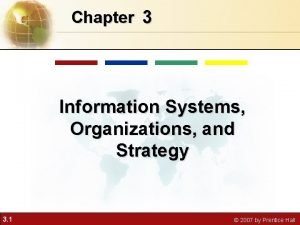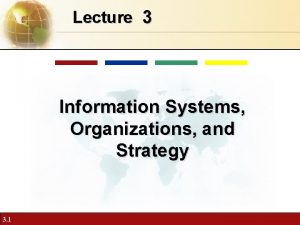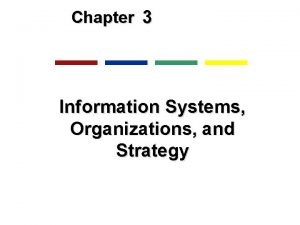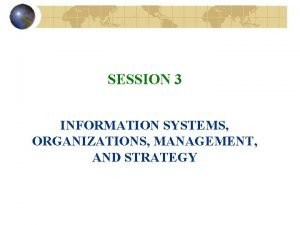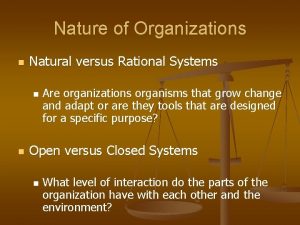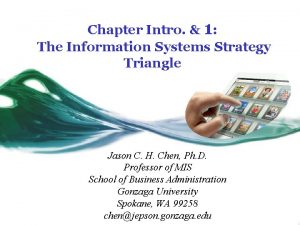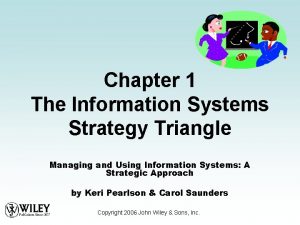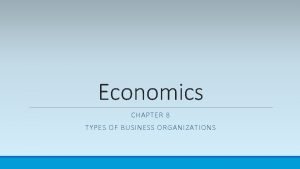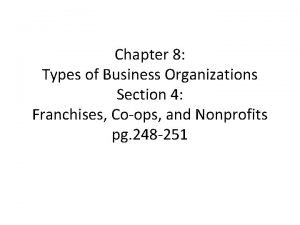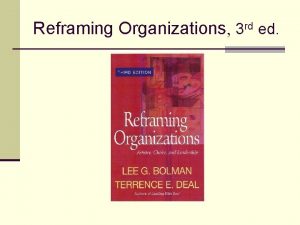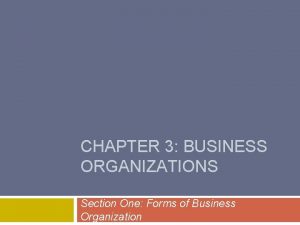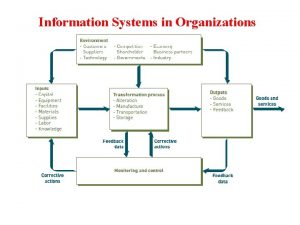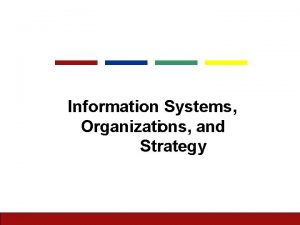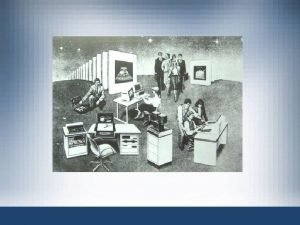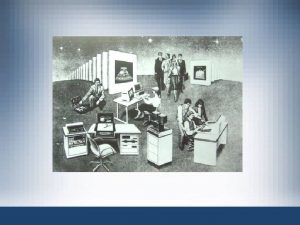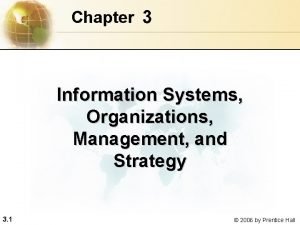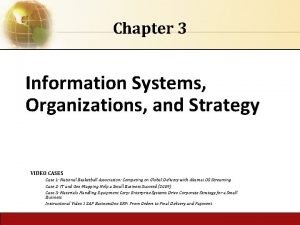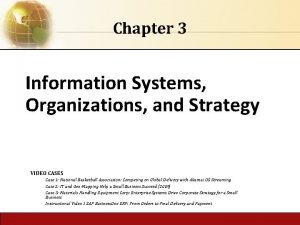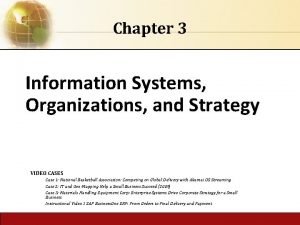Chapter 1 Information Systems Organizations and Strategy 3


















- Slides: 18

Chapter 1 Information Systems, Organizations, and Strategy 3. 1 © 2010 by Prentice Hall

Management Information Systems Chapter 3 Information Systems, Organizations, and Strategy Organizations and Information Systems • Information technology and organizations influence one another • Complex relationship influenced by organization’s structure, business processes, politics, culture, environment, and management decisions 3. 2 © 2010 by Prentice Hall

Management Information Systems Chapter 3 Information Systems, Organizations, and Strategy Organizations and Information Systems The Two-Way Relationship Between Organizations and Information Technology This complex two-way relationship is mediated by many factors, not the least of which are the decisions made—or not made—by managers. Other factors mediating the relationship include the organizational culture, structure, politics, business processes, and environment. 3. 3 Figure 3 -1 © 2010 by Prentice Hall

Management Information Systems Chapter 3 Information Systems, Organizations, and Strategy Organizations and Information Systems • What is an organization? • Technical definition: • Stable, formal social structure that takes resources from environment and processes them to produce outputs • A formal legal entity with internal rules and procedures, as well as a social structure • Behavioral definition: • A collection of rights, privileges, obligations, and responsibilities that is delicately balanced over a period of time through conflict and conflict resolution 3. 4 © 2010 by Prentice Hall

Management Information Systems Chapter 3 Information Systems, Organizations, and Strategy Organizations and Information Systems The Technical Microeconomic Definition of the Organization In the microeconomic definition of organizations, capital and labor (the primary production factors provided by the environment) are transformed by the firm through the production process into products and services (outputs to the environment). The products and services are consumed by the environment, which supplies additional capital and labor as inputs in the feedback loop. 3. 5 Figure 3 -2 © 2010 by Prentice Hall

Management Information Systems Chapter 3 Information Systems, Organizations, and Strategy Organizations and Information Systems The Behavioral View of Organizations The behavioral view of organizations emphasizes group relationships, values, and structures. 3. 6 Figure 3 -3 © 2010 by Prentice Hall

Management Information Systems Chapter 3 Information Systems, Organizations, and Strategy Organizations and Information Systems • Features of organizations • All modern organizations share some characteristics, such as: • Use of hierarchical structure • Accountability, authority in system of impartial decision making • Adherence to principle of efficiency • Other features include: Routines and business processes and organizational politics, culture, environments and structures 3. 7 © 2010 by Prentice Hall

Management Information Systems Chapter 3 Information Systems, Organizations, and Strategy Organizations and Information Systems • Routines and business processes • Routines (standard operating procedures) • Precise rules, procedures, and practices developed to cope with virtually all expected situations • Business processes: Collections of routines • Business firm: Collection of business processes 3. 8 © 2010 by Prentice Hall

Management Information Systems Chapter 3 Information Systems, Organizations, and Strategy Organizations and Information Systems • Organizational culture: • Encompasses set of assumptions that define goal and product • What products the organization should produce • How and where it should be produced • For whom the products should be produced • May be powerful unifying force as well as restraint on change 3. 9 © 2010 by Prentice Hall

Management Information Systems Chapter 3 Information Systems, Organizations, and Strategy Organizations and Information Systems • Organizational environments: • Organizations and environments have a reciprocal relationship • Organizations are open to, and dependent on, the social and physical environment • Organizations can influence their environments • Environments generally change faster than organizations • Information systems can be instrument of environmental scanning, act as a lens 3. 10 © 2010 by Prentice Hall

Management Information Systems Chapter 3 Information Systems, Organizations, and Strategy Organizations and Information Systems • Disruptive technologies • Technology that brings about sweeping change to businesses, industries, markets • Examples: personal computers, word processing software, the Internet. • First movers and fast followers • First movers – inventors of disruptive technologies • Fast followers – firms with the size and resources to capitalize on that technology 3. 11 © 2010 by Prentice Hall

Management Information Systems Chapter 3 Information Systems, Organizations, and Strategy Organizations and Information Systems • Organizational structure • Five basic kinds of structure • Entrepreneurial: Small start-up business • Machine bureaucracy: Midsize manufacturing firm • Divisionalized bureaucracy: Fortune 500 firms • Professional bureaucracy: Law firms, school systems, hospitals • Adhocracy: Consulting firms 3. 12 © 2010 by Prentice Hall

Management Information Systems Chapter 3 Information Systems, Organizations, and Strategy Organizations and Information Systems • Other Organizational Features • Goals • Constituencies • Leadership styles • Tasks • Surrounding environments 3. 13 © 2010 by Prentice Hall

Management Information Systems Chapter 3 Information Systems, Organizations, and Strategy How Information Systems Impact Organizations and Business Firms • Economic impacts • IT changes relative costs of capital and the costs of information • Information systems technology is a factor of production, like capital and labor • IT affects the cost and quality of information and changes economics of information • Information technology helps firms contract in size because it can reduce transaction costs (the cost of participating in markets) • Outsourcing 3. 14 © 2010 by Prentice Hall

Management Information Systems Chapter 3 Information Systems, Organizations, and Strategy How Information Systems Impact Organizations and Business Firms • Organizational and behavioral impacts • IT flattens organizations • Decision making pushed to lower levels • Fewer managers needed (IT enables faster decision making and increases span of control) • Postindustrial organizations • Organizations flatten because in postindustrial societies, authority increasingly relies on knowledge and competence rather than formal positions 3. 15 © 2010 by Prentice Hall

Management Information Systems Chapter 3 Information Systems, Organizations, and Strategy How Information Systems Impact Organizations and Business Firms • Organizational resistance to change • Information systems become bound up in organizational politics because they influence access to a key resource – information • Information systems potentially change an organization’s structure, culture, politics, and work • Most common reason for failure of large projects is due to organizational and political resistance to change 3. 16 © 2010 by Prentice Hall

Management Information Systems Chapter 3 Information Systems, Organizations, and Strategy How Information Systems Impact Organizations and Business Firms • The Internet and organizations • The Internet increases the accessibility, storage, and distribution of information and knowledge for organizations • The Internet can greatly lower transaction and agency costs • Example: Large firm delivers internal manuals to employees via corporate Web site, saving millions of dollars in distribution costs 3. 17 © 2010 by Prentice Hall

Management Information Systems Chapter 3 Information Systems, Organizations, and Strategy How Information Systems Impact Organizations and Business Firms • Central organizational factors to consider when planning a new system: • Environment • Structure • Hierarchy, specialization, routines, business processes • Culture and politics • Type of organization and style of leadership • Main interest groups affected by system; attitudes of end users • Tasks, decisions, and business processes the system will assist 3. 18 © 2010 by Prentice Hall
 Chapter 3 information systems organizations and strategy
Chapter 3 information systems organizations and strategy Information systems, organizations, and strategy
Information systems, organizations, and strategy Information systems, organizations, and strategy
Information systems, organizations, and strategy Information systems, organizations, and strategy
Information systems, organizations, and strategy Information systems organizations and strategy
Information systems organizations and strategy Natural system organization
Natural system organization Information system strategy triangle example
Information system strategy triangle example Information system strategy matrix
Information system strategy matrix Introduction to management chapter 1
Introduction to management chapter 1 Chapter 4 ethical issues
Chapter 4 ethical issues Chapter 4 ethical and social issues in information systems
Chapter 4 ethical and social issues in information systems Chapter 8 business organizations
Chapter 8 business organizations Chapter 8 section 4
Chapter 8 section 4 Chapter 8 business organizations
Chapter 8 business organizations Reframing organizations chapter 3 summary
Reframing organizations chapter 3 summary Chapter 3 business organizations
Chapter 3 business organizations Management information system chapter 1
Management information system chapter 1 Securing information systems
Securing information systems Chapter 8 securing information systems
Chapter 8 securing information systems

